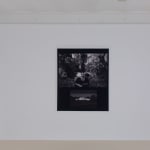Jermaine Francis
93 3/4 x 44 ins
Exhibitions
'Jermaine Francis. A Storied Ground' at the Centre for British Photography, London (8 June - 24 September 2023)This work comes from the series A Storied Ground which was premiered in Paris in 2022 and shown for the first time in London at the Centre for British Photography in 2023 as part of Jermaine Francis' solo show.
In this series Francis uses multiple images to explore a Black presence in the countryside.
Historically the Black figure is absent in the English landscape, which has a strong relationship to nationalism and colonialism. Francis considers how these codes infiltrate and influence how the Black figure is seen.
As Song Tae Chong explains:
“The visuality of British Landscape painting in the tradition of such luminaries as Sir Thomas Gainsborough, Sir Joshua Reynolds and Sir John Constable have long provided viewers with a pastoral history of the British Landscape as an idealized and romantic one, free of the politics of the time and offering an aesthetic paradigm for the fabled “English countryside” that we know today. But the visual culture that produced those sweeping pastoral views, sometimes populated by wealthy white landowners, dressed in the finest garments of the time and enjoying leisure activities that were decidedly of the titled class. In fact, those sweeping views also contained nuanced messages pertaining to white ownership of that landscape, the right to surveil their own private property, and the centrality of the white body as both owner and natural and “neutral” inhabitant of that landscape.
Using those same gestures as the centrality of the body occupying space, Jermaine Francis’ project obliges the viewer to think about who is considered a natural inhabitant of the British landscape. The history and the visualization of the landscape is about property and wealth, and embedded are deeper meanings alluding to a sense of belonging and ownership. This project situates the black body within those landscapes with both an unflinching primacy as well as a natural ease. The participants of Francis’ photographs do not offer a reason to justify their position in the landscape: they have a right to occupy that space without explanation.”



